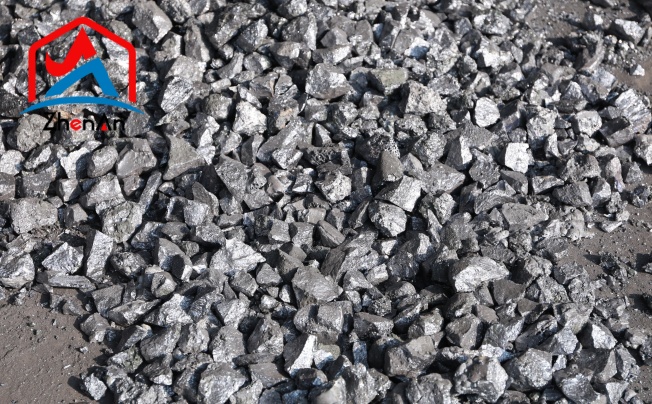Anthracite
Anthracite is a type of coal known for its lustrous appearance and high carbon content, making it one of the purest forms of coal available. With a carbon content ranging from 92% to 98%, anthracite is prized for its clean-burning properties and high energy output.
Unlike other types of coal, anthracite has low volatile matter, which means it produces less smoke and emissions when burned. This characteristic makes anthracite an environmentally friendly option for heating and industrial processes.
In addition to its high carbon content, anthracite is distinguished by its high fixed carbon content, typically exceeding 80%. Fixed carbon refers to the solid combustible residue left after volatile matter is driven off during combustion.
This attribute gives anthracite a distinct advantage in terms of energy efficiency, as it burns more cleanly and efficiently than lower-grade coals. The combination of high carbon and fixed carbon content in anthracite contributes to its status as a premium-grade coal with superior heat-generating capabilities.
Anthracite coal derives its unique properties from the geological processes that form it deep within the earth's crust. Originating from metamorphic rock formations subjected to intense pressure and heat over millions of years, anthracite undergoes a transformation that compresses its organic matter into a dense, hard substance.
This process eliminates impurities and moisture, resulting in a remarkably pure form of coal with exceptional burning characteristics. Geologically significant formations like the Appalachian Mountains in the United States are renowned for their deposits of high-quality anthracite coal.
The intense geological pressures experienced in these regions have fostered the development of vast reserves of anthracite, making them prime locations for mining operations. Due to its purity and energy efficiency, anthracite holds a revered status among coals and plays a crucial role in various industries where clean-burning fuel is essential for optimal performance.
Petroleum Coke (Petcoke)
Definition and Composition
Petroleum coke, commonly referred to as Petcoke, is a carbonaceous solid derived from the oil refining process. It is a byproduct obtained from the residue left after the distillation of heavy crude oils. This residue is then further processed to extract petroleum coke, which is characterized by its high carbon content.
Petcoke typically contains around 90% carbon, making it a valuable source of fuel and raw material for various industries. Despite its high carbon content, Petcoke has a lower energy value compared to Anthracite, a premium-grade coal known for its efficiency in energy production.
This lower calorific value of petroleum coke makes it less ideal for certain applications where high energy output is crucial. However, the abundance and relatively low cost of Petcoke make it a popular choice in industries where cost-effectiveness outweighs energy efficiency considerations.
Types of Petcoke
There are two main types of Petroleum Coke based on their processing methods: Calcined Petcoke and Green Petcoke. Calcined Petcoke undergoes a heat treatment process to improve its quality and purity for industrial applications. This treatment removes volatile matter and contaminants, enhancing the fuel's performance in various processes such as steel production or aluminum smelting.
On the other hand, Green Petcoke refers to the raw or untreated form of petroleum coke. Green Petcoke is commonly used as a fuel source in power plants or cement kilns due to its relatively lower cost compared to other fuels like coal or natural gas.
While Green Petcoke may contain higher levels of impurities compared to Calcined Petcoke, its affordability and availability make it an attractive option for industries looking to reduce operational costs without compromising on fuel quality. Through understanding the composition and types of Petroleum Coke (Petcoke), industries can make informed decisions regarding its usage based on their specific needs for energy efficiency, cost-effectiveness, and environmental impact considerations.
Energy Content and Efficiency
Anthracite stands out for its remarkable calorific value, making it a highly sought-after fuel source. With its high carbon content and low volatile matter, anthracite boasts a superior energy output compared to petroleum coke. This exceptional efficiency makes anthracite a preferred choice for applications where energy intensity is crucial, such as in industrial processes or residential heating.
In contrast, petroleum coke falls short in terms of energy production efficiency when pitted against anthracite. Despite also being carbon-rich, the lower calorific value of petroleum coke hinders its effectiveness as a fuel source.
Industries relying on petroleum coke may face challenges in achieving optimal energy output due to its comparatively lower efficiency levels. This disparity underscores the importance of understanding the distinct characteristics of these two carbonaceous materials.
Composition and Impurities
Anthracite's Purity Advantage
One of the defining features of anthracite is its natural purity, characterized by minimal impurities. This premium-grade coal typically exhibits low sulfur content and contains fewer undesirable elements like metals and ash, enhancing its desirability for various applications. The clean composition of anthracite contributes to cleaner combustion processes and reduced environmental impact compared to petroleum coke.
Petroleum Coke's Environmental Concerns
Conversely, petroleum coke may pose environmental challenges due to its composition, which can include higher sulfur content along with other impurities like metals and ash. The presence of sulfur in petroleum coke raises concerns about emissions during combustion processes, potentially leading to air pollution issues if not managed effectively. Understanding these compositional differences between anthracite and petroleum coke is essential for making informed decisions regarding their usage in different industries.
Use in Industries
Diverse Applications of Anthracite
Anthracite finds widespread use across various industries, ranging from residential heating to metallurgical processes. Its high energy density and purity make it a valuable resource for heating homes efficiently, as well as serving as a crucial component in steel production and other metallurgical applications. The versatility of anthracite positions it as a versatile fuel source capable of meeting diverse industrial needs.






